Deep Focus: A Wrinkle in Time
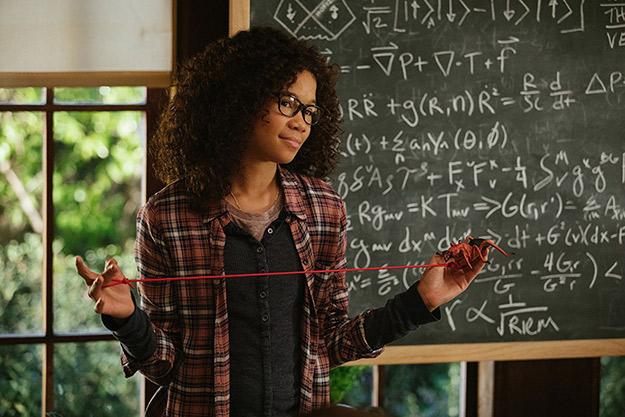
Coming fresh to the beloved tween/Young Adult science-fiction odyssey A Wrinkle in Time, I kept thinking of its author Madeleine L’Engle (1918-2007) as an outsider artist. In mysterious and unconscious ways, her gimcrack construction expresses home truths about children’s need to see themselves and their families intelligently and honestly but still lovingly, while figuring out their place in the universe. As a craftsperson, she’s like an educated, literary version of those self-taught sketchers, tinkers, and sculptors who fill backyards, storage rooms and cramped city apartments with drawings, gewgaws, and wire-hanger contraptions. Her work’s power derives from its quirky shape and the way it makes her private mythology accessible and, for kids, exciting.
She had published two novels before, but 26 publishers rejected L’Engle’s book before it landed at Farrar, Straus and Giroux in 1962, and it’s easy so see why. The plot overloads a primal crusade story with a bunch of moving parts, and, 56 years later, the movie generally stays faithful to it. Once again, a 14-year-old misfit girl, Meg Murry (Storm Reid), journeys with her five-year-old genius brother, Charles Wallace (Deric McCabe), and their stouthearted new friend, Calvin O’Keefe (Levi Miller), on a quest to find her loving physicist father (Chris Pine). He’s disappeared without a trace. Although they leave behind Meg and Charles Wallace’s physicist mother (GuGu Mbatha-Raw), three other potent females—gnomic guardian angels known as Mrs. Whatsit (Reese Witherspoon), Mrs. Who (Mindy Kaling), and Mrs. Which (Oprah Winfrey)—both enable them to “tesser” through distant galaxies (more on that later) and, along the way, engage them in the ongoing cosmic fight between good and evil. Midway through, the children must start trying to bring literal and spiritual light to a morally and physically dark orb, “Camazotz” (sounds like a bizarro rendering of “Camelot”), where Dr. Murry is imprisoned.
L’Engle adorned her yarn with material from quantum physics, Greco-Roman mythology, and European and American fairy tales, notably The Wizard of Oz, along with an array of 20th-century preoccupations: Einstein’s theory of relativity, Communist brainwashing and capitalistic conformity, mindless consumption, and the danger of overvaluing security and convenience. Yet L’Engle’s book has succeeded in selling over 14 million copies, and her adolescent female variation on a Joseph Campbell hero has been viewed as an influence on Hermione Grainger in the Harry Potter series and Katniss Everdeen in The Hunger Games. L’Engle’s bizarre adventure became a blockbuster because its creator had some mainstream instincts for whimsy, color, action, and uplift. But it’s her eccentric sensibility that sticks with you. The story’s variety keeps us guessing. Whether or not L’Engle’s imagination is first-rate, it’s certainly expansive and unsettling.
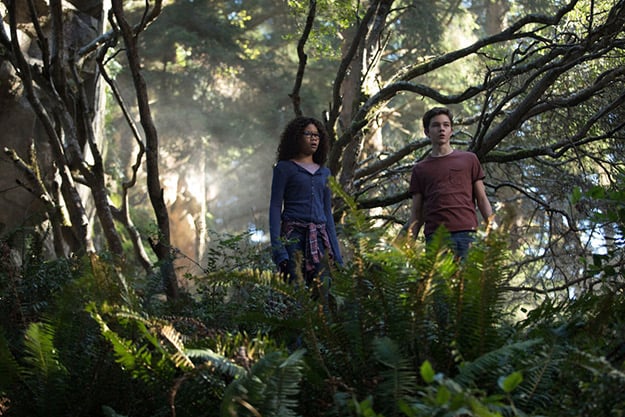
The film version of A Wrinkle in Time has reaped heaps of positive advance publicity, including a Time cover story last December. The studio chose Ava DuVernay, best known for the Martin Luther King Jr. biopic Selma, to helm this $100 million fantasy film. DuVernay did move boldly, assembling a diverse cast. Mbatha-Raw as the astrophysicist Dr. Murry, Pine as the theoretical-physicist Dr. Murry, Reid as Meg, and Filipino actor McCabe as Charles Wallace—here, he’s adopted—make an attractive multiracial family. (The movie drops Meg’s “normal” twin brothers.)
In nearly every other way, the adaptation is an insider variant on outsider art. It’s been made with a combination of complacency and misplaced confidence. In some ways it’s a throwback to the era when Disney owned the very concept of family films, except it isn’t as entertaining (not even for kids, I’d guess) as The Shaggy Dog or The Absent-Minded Professor. The filmmakers organize the human comedy-drama into a deluxe after-school soap opera that’s as much about Meg’s need for self-esteem as it is about her devotion to her family. They emphasize her gradual ability to embrace her obstinate faults as virtues in disguise. By the end I expected to hear Whitney Houston on the sound track warbling, “Learning to love yourself / It is the greatest love of all.” And DuVernay’s production team whips the fantasy elements into CGI razzle—hold the dazzle. The science fiction hinges on L’Engle’s notion of “the tesseract” not merely as a geometric concept (a kind of hyper-cube) but also as a fifth dimension that allows humans to “wrinkle” time and space. As the father says in the film, with a tesseract he can travel 91 billion light years in the time it takes to snap a finger.
Unfortunately, when you lose the freshness of L’Engle’s peculiar voice, her playful sci-fi concepts come to seem weighty and pretentious. Both the movie’s family drama and its speculative fiction sputter out because DuVernay and her chief screenwriter, Jennifer Lee, can’t sustain a smart, volatile teen girl’s point of view. In the book, L’Engle’s empathetic but unsparing closeness to her hero keeps a reader looping along with the fantastical narrative curlicues. In every chapter L’Engle digs into Meg’s antsy, furious, stubborn yet compassionate heart and mind and emerges with some tactile expression of her character, whether it’s a “spasm of pain” or a “pulse of joy.” Lee doesn’t establish that degree of psychic intimacy, and although Reid is a game young actor, DuVernay can’t approximate it with her frequent close-ups.
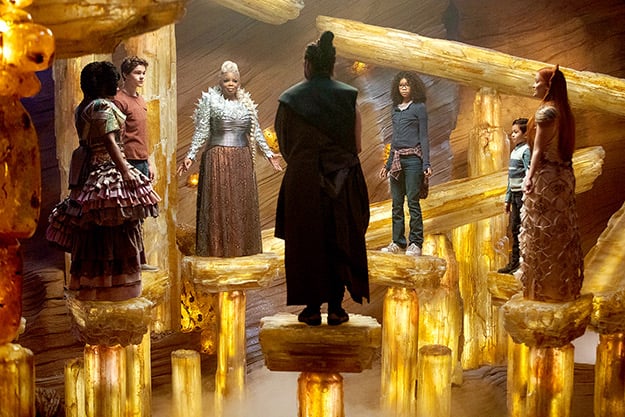
Unable or unwilling to find unconventional means to tell a very odd story, the filmmakers hack up the book’s narrative into slick and simple building blocks, then mortar them together piece by piece. (You can almost see the index cards pinned to the production office wall.) Meg learns that a heart folded into a paper toy is, like her father’s love, hidden but never gone. The Drs. Murry make a presentation to fellow scientists who disdain their theories of time-space wrinkling, spurring Meg’s dad to prove, no matter the potential cost to his family, that it can be done. Setup follows setup. When Charles Wallace overhears two teachers gossiping about his father’s disappearance, the staging is so perfunctory and the characters so devoid of character that the scene should carry an aesthetic trigger warning: “Exposition! Plot point!” (Speaking of plot: Why are the upperclassman Calvin and the kindergarten-age Charles Wallace hanging out at the James Baldwin Middle School?) Calvin admires Meg on the school playground when she slams a ball off of mean girl Veronica (Rowan Blanchard). He’s been cast as such a conventional dreamboat (where are Calvin’s cascading freckles?) that we know he’ll emerge as her enlightened feminist Prince Charming.
As the fantastical elements kick in, the director frames the action like a fatigued magician presenting each new wonder with a dull “Ta-daa!” As in the book, Reese Witherspoon’s Mrs. Whatsit gallivants into the Murry home in a dress she’s put together from pilfered sheets. Unfortunately, to see this type of thing done wittily and well, we’d have to go back to Carol Burnett’s Scarlett O’Hara confronting Rhett Butler in a dress made from drapery, complete with curtain rods. The atmosphere is so unsteady that the usually reliable Witherspoon, as the youngest and most unpredictable Mrs., backs into a facetious tone that puts her dialogue in air quotes without making it airy. In a movie that reduces most of its actors to playing in one key, Pine wins our affection by doing the opposite. He puts his all into each aspect of Dr. Murry’s character: his love for his family, his avid curiosity, and the tug-of-war raging in his head between his cosmic intellectual ambitions and his knowledge that there’s no place like home.
Screenwriter Jennifer Lee, who co-wrote the film with John Stockwell, has been tirelessly promoted as the writer-co-director of Frozen, but, I ask you, what made that cartoon feature a smash—the lumpy comedy-drama or the earworm score? There was a ton of prologue in Frozen and there are two tons here. We get successive introductory scenes, though most of the characters need no introduction. They announce their true nature as soon as they step in front of the camera, and they never deviate from it. Mrs. Who (Mindi Kaling) speaks only in quotations (as she also does in the book). We eventually meet her in a pseudo-dilapidated cottage surrounded by piles of dusty tomes meticulously designed to be a mess. In the film Mrs. Who does quote more contemporary sources, like the hip hop duo Outkast, as well as additional voices from other cultures, like the Persian poet Rumi. In fact, Rumi contributes a central thought: “The wound is the place where the light enters you.” The Missusses later shoot Meg full of light when she feels physically and psychologically wounded.
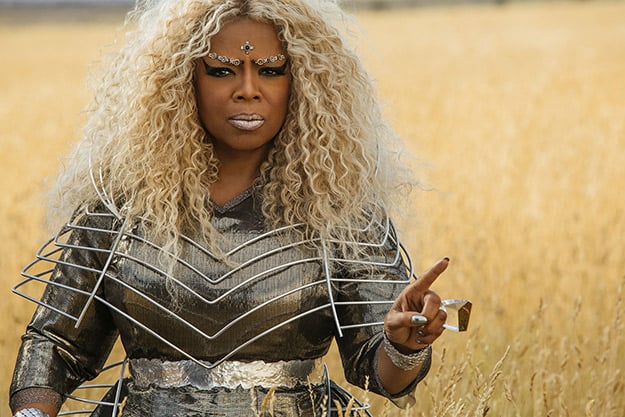
The actors playing the Missuses follow Jack Nicholson’s advice to Michael Keaton on Batman: “We just gotta let the wardrobe do the acting, Kid.” And for the Missuses, that’s a big mistake. DuVernay and Lee extract just a tincture of personality from L’Engle’s book and eye-drop it into the picture whenever L’Engles’s astral creatures take a break from defending everything that’s honest, decent, and true in the whole wide universe. Witherspoon’s Whatsit is flippant mingled with sarcastic; Kaling’s Who is comically owlish, up to her owlish specs; and Winfrey’s Which towers over both of them, authoritative and majestic. Their performances are so flimsy that they all seem to be play-acting. With multiple costume changes and hair adjustments, Witherspoon, clad in flowing whites and floral designs, comes off as an awkward nymph, while Kaling, dressed in Japanese and Colombian colors and designs, could be trying out for a light opera. The Divine Ms. O shows up just when you’re thinking, “The only person who could make this film even more au courant or ‘of the moment’ is Oprah Winfrey.”
Honestly, I can’t claim to know what becomes a legend most, but I can tell it’s not getting dressed and coiffed like a Viking warrior queen and delivering would-be words of warrior wisdom in stentorian tones. DuVernay told Time, “I wasn’t just casting for actresses. I was casting for leaders—icons.” So that meant Witherspoon as “the hottest producer in town,” Winfrey as “the most prolific, venerable legend of television and an artist and entrepreneur,” and Kaling as “one of the few women running a show with her name, about her.” None of that translates into their play-acting as celestial beings.
It’s admirable for DuVernay to try to stretch and express herself in the world of digital effects. But in this movie she displays a straightforward sociopolitical agenda rather than a keen sensibility. She doesn’t squeeze the metaphorical juice out of the material: when it comes to the story’s attacks on contemporary group-think, intellectual elitism, and life on the grid, she merely checks each box. Most important, she fails to mount the splashy action from deep inside so that we get under Meg’s skin and experience each tingle of her multiple plunges into the void.
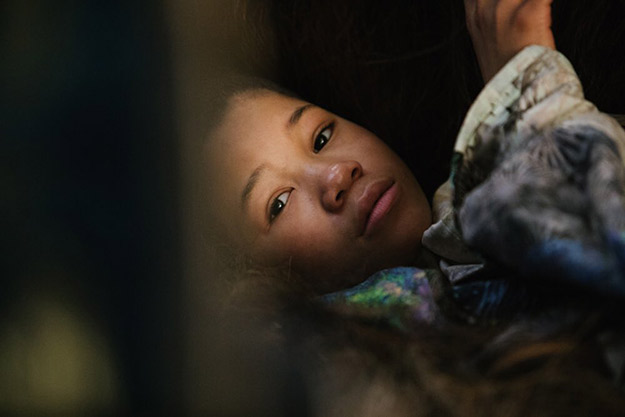
The filmmakers have spent tens of millions on hybrid creatures like sentient flowers who talk “in color” and a flying serpent-butterfly, on eye-popping chromatic light shows, simulated tornadoes, and eerie white-on-white illuminations. But there’s nothing comparable in this movie to the way, say, the National Theatre stage production of The Curious Incident of the Dog in the Night-Time choreographed stage lights to externalize the mindset of an autistic child. DuVernay does her finest work in suburban Camazotz, where little girls skip rope and little boys dribble basketballs at appointed times, in chilling unison. (Paige Bellamy makes an amusing cameo as a Stepford Mom.) But that sequence may just be surefire: it was effective even in the paralyzingly bland 2003 TV version.
DuVernay has neither the protean power to subsume L’Engle’s work into a fantasy of her own, nor the humble artisan’s touch to translate the book’s pages into simple, expressive imagery. In 2012, a comic-book artist named Hope Larson displayed both. Larson’s graphic-novel adaptation, rendered in a modest palette of turquoise, black, and white, concentrates on soulful, bluesy portraiture and adheres ruthlessly to Meg’s point of view. Relying on the power of suggestion, she employs readers’ own runaway imaginations to fill out her panoramas of alien life and uncharted space.
Larson’s personal, minimalist take on A Wrinkle in Time provides a fresh portal into L’Engle’s corkscrew vision. Disney and DuVernay clutter the view.
Michael Sragow is a contributing editor to Film Comment and writes its Deep Focus column. He is a member of the National Society of Film Critics and the Los Angeles Film Critics Association, and a programmer at the Criterion Collection.







